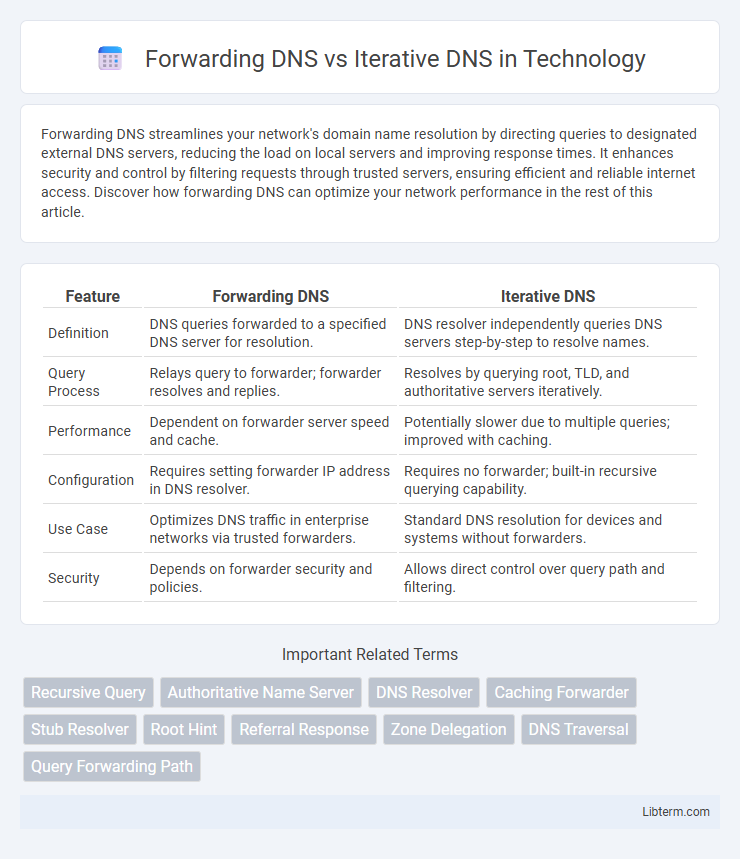Forwarding DNS streamlines your network's domain name resolution by directing queries to designated external DNS servers, reducing the load on local servers and improving response times. It enhances security and control by filtering requests through trusted servers, ensuring efficient and reliable internet access. Discover how forwarding DNS can optimize your network performance in the rest of this article.
Table of Comparison
| Feature | Forwarding DNS | Iterative DNS |
|---|---|---|
| Definition | DNS queries forwarded to a specified DNS server for resolution. | DNS resolver independently queries DNS servers step-by-step to resolve names. |
| Query Process | Relays query to forwarder; forwarder resolves and replies. | Resolves by querying root, TLD, and authoritative servers iteratively. |
| Performance | Dependent on forwarder server speed and cache. | Potentially slower due to multiple queries; improved with caching. |
| Configuration | Requires setting forwarder IP address in DNS resolver. | Requires no forwarder; built-in recursive querying capability. |
| Use Case | Optimizes DNS traffic in enterprise networks via trusted forwarders. | Standard DNS resolution for devices and systems without forwarders. |
| Security | Depends on forwarder security and policies. | Allows direct control over query path and filtering. |
Introduction to DNS Resolution
DNS resolution involves translating domain names into IP addresses, essential for internet functionality. Forwarding DNS resolution relies on a designated forwarder server to handle queries on behalf of the client, reducing query time and centralized traffic management. Iterative DNS resolution requires the client to query multiple DNS servers sequentially, starting from the root, until the authoritative server for the domain is found, ensuring direct control over each resolution step.
Understanding Forwarding DNS
Forwarding DNS involves a DNS server forwarding client queries to an external DNS server rather than resolving the queries itself, enhancing performance and security by centralizing DNS traffic. It reduces the workload on local DNS servers and allows for better control over DNS resolution policies and caching. This method is particularly advantageous in corporate networks where DNS queries can be filtered and monitored through a dedicated forwarder.
What is Iterative DNS?
Iterative DNS is a query process where the DNS resolver requests information step-by-step from multiple DNS servers until it obtains the final IP address. Each server returns the best possible answer it can provide, often directing the resolver to the next server in the DNS hierarchy. This approach contrasts with forwarding DNS, where queries are sent to a designated forwarder server that handles the complete resolution.
Key Differences Between Forwarding and Iterative DNS
Forwarding DNS involves sending DNS queries from a client to a designated forwarder server, which handles the resolution process on behalf of the client, reducing client-side resource usage and centralizing DNS traffic management. Iterative DNS requires the client resolver to perform multiple queries progressively, contacting authoritative DNS servers in sequence until the final answer is obtained, offering greater control over query resolution but increasing client-side complexity. Key differences include the direction of query handling--forwarder-centric in forwarding DNS versus resolver-driven in iterative DNS--and the distribution of workload and caching responsibilities between client and DNS servers.
How Forwarding DNS Works
Forwarding DNS operates by directing client queries to a designated forwarder server, which then resolves the query on behalf of the client, reducing the load on the local DNS server. This method improves efficiency and control by centralizing DNS request handling, often used within corporate networks to enforce DNS policies. The forwarder server performs recursive queries and returns the final DNS resolution, allowing the local server to bypass iterative query resolution steps.
How Iterative DNS Works
Iterative DNS works by the DNS resolver querying each DNS server sequentially, starting from the root server, then proceeding to the top-level domain (TLD) server, and finally reaching the authoritative server for the domain. Each server provides a referral to the next server closer to the desired domain name, allowing the resolver to progressively narrow down the IP address. This step-by-step querying process contrasts with forwarding DNS, where a single forwarder handles the entire resolution on behalf of the client.
Advantages of Forwarding DNS
Forwarding DNS enhances network efficiency by centralizing DNS query processing, reducing external traffic, and minimizing latency through cached responses. It improves security by filtering out malicious requests before they reach the internal network. This method streamlines DNS management, making it easier to enforce organizational policies and monitor query patterns effectively.
Benefits of Iterative DNS
Iterative DNS queries enhance efficiency by allowing resolvers to contact multiple authoritative servers directly, reducing dependency on intermediary servers and minimizing latency. This approach improves fault tolerance and speeds resolution through parallel queries, optimizing network performance. Iterative DNS also supports better load distribution across DNS servers, enhancing scalability and robustness in large-scale environments.
Use Cases: When to Choose Forwarding vs Iterative DNS
Forwarding DNS is ideal for networks requiring central control over DNS queries, such as enterprise environments needing to filter or cache responses for security and performance optimization. Iterative DNS suits scenarios where direct communication with authoritative servers is preferred, commonly used in public DNS resolvers or distributed systems demanding real-time data accuracy. Choosing forwarding DNS improves administrative control and simplifies troubleshooting, while iterative DNS offers faster, decentralized query resolution suitable for high-availability applications.
Security Considerations in DNS Resolution
Forwarding DNS enhances security by centralizing DNS queries through a trusted forwarder, enabling better control, logging, and filtering of malicious requests, which reduces exposure to external threats. Iterative DNS resolution relies on multiple DNS servers in a chain, increasing the attack surface and vulnerability to cache poisoning and spoofing attacks due to less centralized control. Implementing DNSSEC and strict access controls is crucial in both methods to ensure data integrity and prevent DNS-based attacks.
Forwarding DNS Infographic

 libterm.com
libterm.com